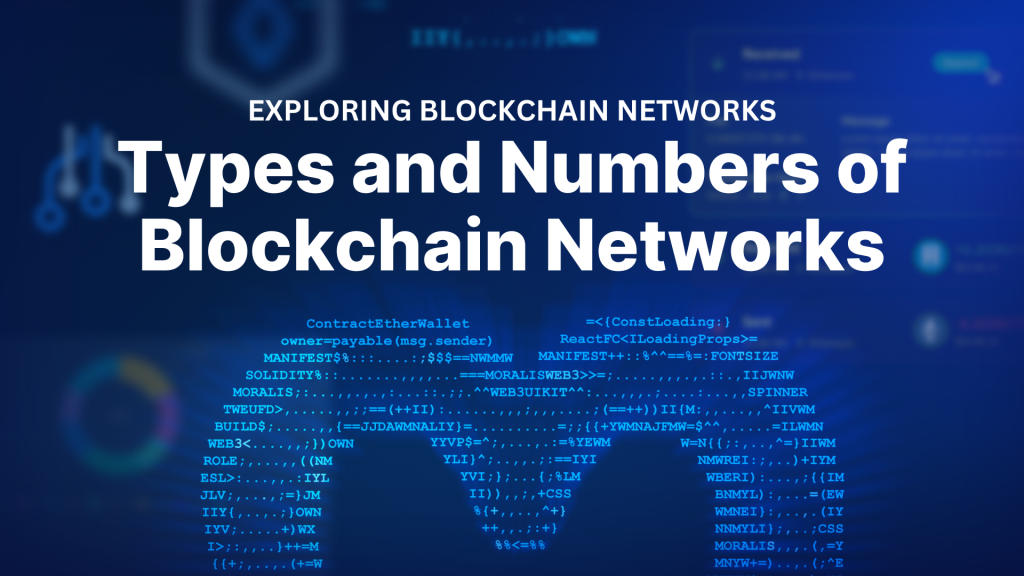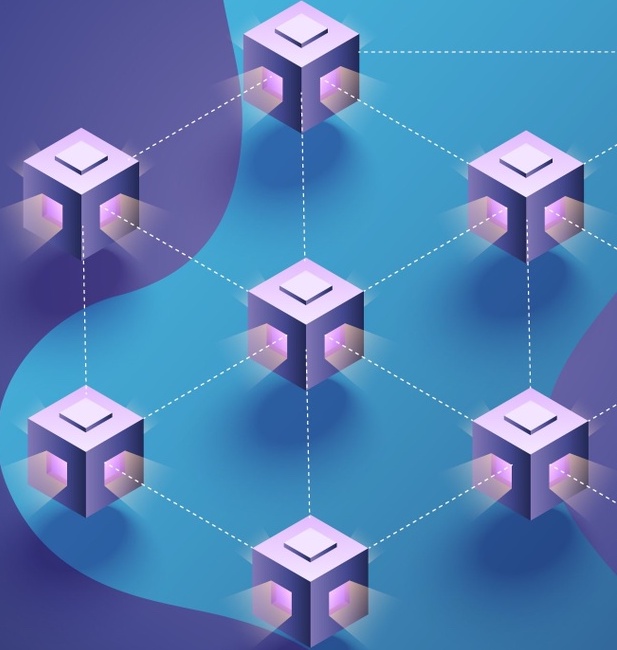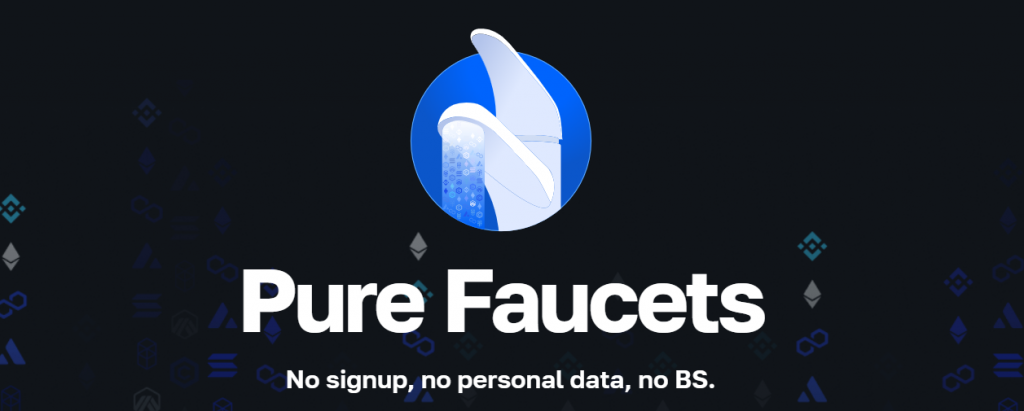[ad_1]

The Web3 space is vast, and it’s growing bigger and bigger every day. And not only are we seeing new decentralized applications (dapps) pop up frequently, but new blockchains continuously emerge as well. So, how many blockchains are there? And what are the different types of blockchains? Join us in this article as we address both of these queries to provide clarity into the ever-expanding landscape of Web3!
Overview
We’ll kickstart today’s article by answering the question: ”How many blockchains are there?”. From there, we’ll dive straight into the different types of blockchains. In doing so, we’ll explore what they are, why they exist, and cover some prominent examples for each type. Next, we’ll also explore different types of blockchains for developers. To go along with that, we’ll top things off by introducing you to the easiest way to build blockchain applications: Moralis’ industry-leading Web3 API suite!
Moralis’ Web3 APIs are the ultimate tools if you’d like to get into blockchain app development. With our industry-leading interfaces, you can build everything from block explorers to NFT games in no time.

Also, did you know that you can sign up with Moralis for free? It only takes a couple of clicks, and you’ll gain immediate access to all our premier Web3 development tools so you can build dapps both faster and smarter!
How Many Blockchains Are There?
There’s a multitude of blockchain networks in existence, and some prominent examples include Bitcoin, Ethereum, Solana, etc. Furthermore, the blockchain space is continuously growing as numerous organizations and projects develop their own chains to address specific needs.
With that said, how many blockchains are there?
Due to the ever-growing state of the Web3 space, the exact count of blockchains is challenging to pinpoint. Nonetheless, estimates suggest that the number of existing blockchains is at least 1,000!
What Are the Different Types of Blockchains?
There are four main types of blockchain networks, including public blockchains, private blockchains, hybrid blockchains, and consortium blockchains. Each type has unique benefits, drawbacks, and ideal use cases. As such, let’s briefly explore them one by one, starting with public blockchains:

- Public Blockchains: Public blockchains are permissionless, meaning they are fully decentralized and open for anyone to participate. These types of networks are most commonly used for exchanging and mining cryptocurrency.
- Private Blockchains: Private blockchains are permissioned, meaning that only a few select people can participate in the network. These networks are typically controlled by an organization or a company, which determines who is granted access to read and write privileges.
- Hybrid Blockchains: Hybrid blockchains are networks that combine features of both public and private chains. These networks are controlled by single entities. However, they can decide who has access to specific data stored on the network and what information will be open to the public.
- Consortium Blockchains: Consortium blockchains are quite similar to hybrid blockchains. However, unlike hybrid blockchains with one controlling entity, consortium blockchains are designed by a group that wants to use the network for collaborative efforts. Users outside of the consortium/group generally can’t get access to the blockchain network.
What Purpose Does the Different Types of Blockchains Serve?
The different types of blockchains have their own sets of unique advantages and disadvantages. In this section, we’ll look closer at what purpose public blockchains, private blockchains, hybrid blockchains, and consortium blockchains serve.
- Public Blockchains: Public blockchain networks have many benefits. Some examples include being completely transparent, fully decentralized, pseudonymous, and open to the public. These advantages make them ideal for use cases such as exchanging cryptocurrencies and organizations built on transparency and trust.
- Private Blockchains: Private blockchain networks excel when it comes to privacy, security, speed, and scalability. These benefits make private blockchains perfect for use cases such as supply chain management, asset ownership, internal voting, etc. In these instances, it’s beneficial for the network to be cryptographically secured, but the controlling entity wants the information to be kept private.

- Hybrid Blockchains: Hybrid blockchains can provide closed ecosystems, high flexibility, privacy with communication, and better scalability. These positive characteristics make hybrid chains ideal for use cases where some, but not all, data needs to be shared with users. For instance, medical records can be stored on a hybrid blockchain, where only users can access their own data via smart contracts.
- Consortium Blockchains: Consortium blockchains also have several advantages, including high security, control, and the possibility of no transaction fees. These benefits make consortium blockchains great for use cases such as banking, payments, and supply chain management. For instance, two banks can come together and form a consortium to make payments more efficient.
Different Types of Blockchain Examples
Now, with an overview of the various different types of blockchains, let’s take this section to explore some examples for each. And to kick things off, we’ll start with public blockchain networks!

Public Blockchain Example
Public blockchains are the most well-known networks. And unless you have been living under a rock for the past few years, odds are you’ve heard of at least one. The two most significant examples are Bitcoin and Ethereum:
- Bitcoin: The Bitcoin blockchain is a proof-of-work-based (PoW) distributed public ledger that launched in 2009. The blockchain hosts the BTC cryptocurrency and is responsible for maintaining the history of every transaction on the network. Moreover, as the Bitcoin blockchain is public, anyone can participate and fetch a copy of the network to track every transfer since its origins.
- Ethereum: Ethereum is a public proof-of-stake (PoS) ledger, and it’s a scalable, programmable, and secure network. With Ethereum being programmable, it is the blockchain of choice for many developers and enterprises looking to create decentralized applications (dapps). Ethereum also has its own native token called ether (ETH), which is used to pay for gas fees on the network.
Private Blockchain Example
Private chains are – as the name indicates – private. Consequently, individual networks aren’t all that interesting since they can be relatively niche. As such, instead of exploring a particular private blockchain example, let’s briefly dive into Hyperledger Fabric – an open-source private blockchain framework.
Hyperledger Fabric is an open-source blockchain framework created by the Linux Foundation. And organizations use the framework to build permissioned and private blockchain networks. Moreover, Hyperledger Fabric offers unique identity management and access control features, making it ideal for various industry applications, including supply chain management, finance, loyalty and reward systems, etc. As such, this framework is typically used in enterprise settings.
Hybrid Blockchain Example
Hybrid chains combine both public and private blockchain features, and a great example is IBM Food Trust – a leading initiative utilizing a hybrid blockchain solution to enhance transparency and traceability in supply chains.
IBM Food Trust’s private blockchain provides a permissioned environment for supply chain participants to distribute sensitive information while simultaneously maintaining privacy. In short, it ensures that only trusted entities gain access to confidential information.
Consortium Blockchain Example
As with the other blockchain types, there are also many different consortium blockchain networks. However, to give you an example, we’ll briefly explore R3 Corda – a blockchain network specially designed for financial services.
R3 Corda is an open-source blockchain project launched in 2016 by a consortium of banks, technology companies, and financial institutions. The project was built on interoperability, security, and privacy principles. And it allows for secure and efficient exchanges of data between parties.
Different Types of Blockchains for Developers
There are also multiple types of blockchains for developers, and they can be categorized in several different ways. However, a popular way to divide them is to classify them as either EVM (Ethereum Virtual Machine) or non-EVM chains.

So, what is the difference between them?
- EVM Chains: EVM-compatible chains can run and execute Ethereum smart contracts. Consequently, developers can write and deploy the same smart contracts across multiple EVM blockchain networks without making any significant changes to the code. Some examples of EVM chains include Ethereum, BNB Smart Chain (BSC), Polygon, etc.
- Non-EVM Chains: Non-EVM chains, on the other hand, are all other networks that aren’t EVM-compatible. Some prominent examples of non-EVM chains include Solana, Polkadot, Cardano, and so on.
Another way to classify both EVM and non-EVM chains is to divide them into layer-1 (L1) or layer-2 (L2) networks:
- L1 Chains: Layer-1 blockchains refer to base networks, and some examples include Ethereum, Solana, Cardano, BSC, etc.
- L2 Chains: Layer-2 blockchains are network protocols layered on top of an L1 solution. An L2 protocol typically leverages the security infrastructure of the L1 network but is more flexible in its ability to scale transaction processing and overall throughput. Examples of L2 blockchains include Polygon, Base, Polygon zkEVM, Optimism, Arbitrum, etc.
Nevertheless, that covers some different types of blockchains for developers. From here, we’ll introduce you to Moralis – the easiest way to build dapps on any blockchain network!
Exploring Moralis: Easiest Way to Build On Different Types of Blockchains
The easiest way for developers to build on multiple different types of blockchains is to leverage Moralis. Moralis is an industry-leading API and blockchain infrastructure provider, and with our interfaces, you can effortlessly build dapps across multiple blockchain networks. Furthermore, Moralis’ Web3 APIs currently power blockchain projects for millions of end users worldwide!

But why should you leverage our APIs specifically?
To answer the question above, let’s explore three benefits of working with Moralis:
- Scalability: All our APIs are built to scale. Consequently, as your projects experience increased adoption, you never have to worry about the performance of your dapps.
- Top Performance: Moralis’ Web3 APIs are industry-leading. Whether you prioritize speed, reliability, or any other metric, our APIs consistently blow the competition out of the water.
- Cross-Chain Compatability: Our APIs are chain agnostic, meaning you can build cross-chain compatible dapps on multiple networks with ease. Some prominent examples of supported chains include Ethereum, BSC, Polygon, Solana, Gnosis, Arbitrum, and many others.
If you’d like to explore our entire suite of premier interfaces, check out the Web3 API page!
Also, along with the Web3 APIs, Moralis has a lot more to offer. For instance, with our crypto faucets page, you can find faucets for all major testnets. If you want to learn more about this, you can, for example, check out our ”What is a Goerli Faucet?” guide and learn how to get Goerli faucet funds in a heartbeat!

Summary: How Many Blockchains Are There, and What Are the Different Types?
In today’s article, we kicked things off by answering the question, ”How many blockchains are there?”. In doing so, we learned that the space continuously grows at a rapid rate, making it hard to pinpoint exactly how many networks there are. However, estimations suggest that there are at least 1,000 blockchains!
From there, we also explored different types of blockchains. In doing so, we learned that there are four main categories:
- Public Chains
- Private Chains
- Hybrid Chains
- Consortium Chains
We also explored different use cases and covered some examples of each blockchain type, where we learned that they all have their advantages and disadvantages. Next, we dove a bit deeper into different types of blockchains for developers, where we covered EVM vs non-EVM chains and L1 vs L2 networks.
To top things off, we introduced you to Moralis and our industry-leading suite of Web3 APIs. In doing so, we learned that they offer unparalleled scalability, top performance, and cross-chain compatibility. As such, if you want to build dapps yourself, don’t forget to sign up with Moralis immediately. You can create an account free of charge, and you’ll gain immediate access to all our premier interfaces so you can build dapps without breaking a sweat!
Also, if you liked this blockchain guide, consider checking out more content here on our Web3 blog. For instance, read about ethers.js, learn the ins and outs of Web3 Python, or explore the intricacies of the blockchain tech stack! Lastly, if you’d like to explore the different types of blockchains, perhaps see them in a “list view”, make sure to check out our Web3 Wiki! Moralis’ Web3 Wiki is the best place to explore blockchain networks, NFT tools, platforms, DeFi dapps, etc! For a brief introduction to our Web3 Wiki, read our “Dapp Store” article!
[ad_2]
Read More: moralis.io








 Bitcoin
Bitcoin  Ethereum
Ethereum  Tether
Tether  XRP
XRP  Solana
Solana  USDC
USDC  TRON
TRON  Dogecoin
Dogecoin  Lido Staked Ether
Lido Staked Ether  Cardano
Cardano  Wrapped Bitcoin
Wrapped Bitcoin  Hyperliquid
Hyperliquid  Wrapped stETH
Wrapped stETH  Sui
Sui  Bitcoin Cash
Bitcoin Cash  LEO Token
LEO Token  Chainlink
Chainlink  Stellar
Stellar  Avalanche
Avalanche  Toncoin
Toncoin  USDS
USDS  WhiteBIT Coin
WhiteBIT Coin  Shiba Inu
Shiba Inu  WETH
WETH  Wrapped eETH
Wrapped eETH  Litecoin
Litecoin  Binance Bridged USDT (BNB Smart Chain)
Binance Bridged USDT (BNB Smart Chain)  Hedera
Hedera  Ethena USDe
Ethena USDe  Monero
Monero  Polkadot
Polkadot  Bitget Token
Bitget Token  Coinbase Wrapped BTC
Coinbase Wrapped BTC  Uniswap
Uniswap  Pepe
Pepe  Pi Network
Pi Network  Aave
Aave  Dai
Dai  Ethena Staked USDe
Ethena Staked USDe  Bittensor
Bittensor  OKB
OKB  BlackRock USD Institutional Digital Liquidity Fund
BlackRock USD Institutional Digital Liquidity Fund  Aptos
Aptos  Internet Computer
Internet Computer  Cronos
Cronos  NEAR Protocol
NEAR Protocol  Jito Staked SOL
Jito Staked SOL  sUSDS
sUSDS  Ethereum Classic
Ethereum Classic